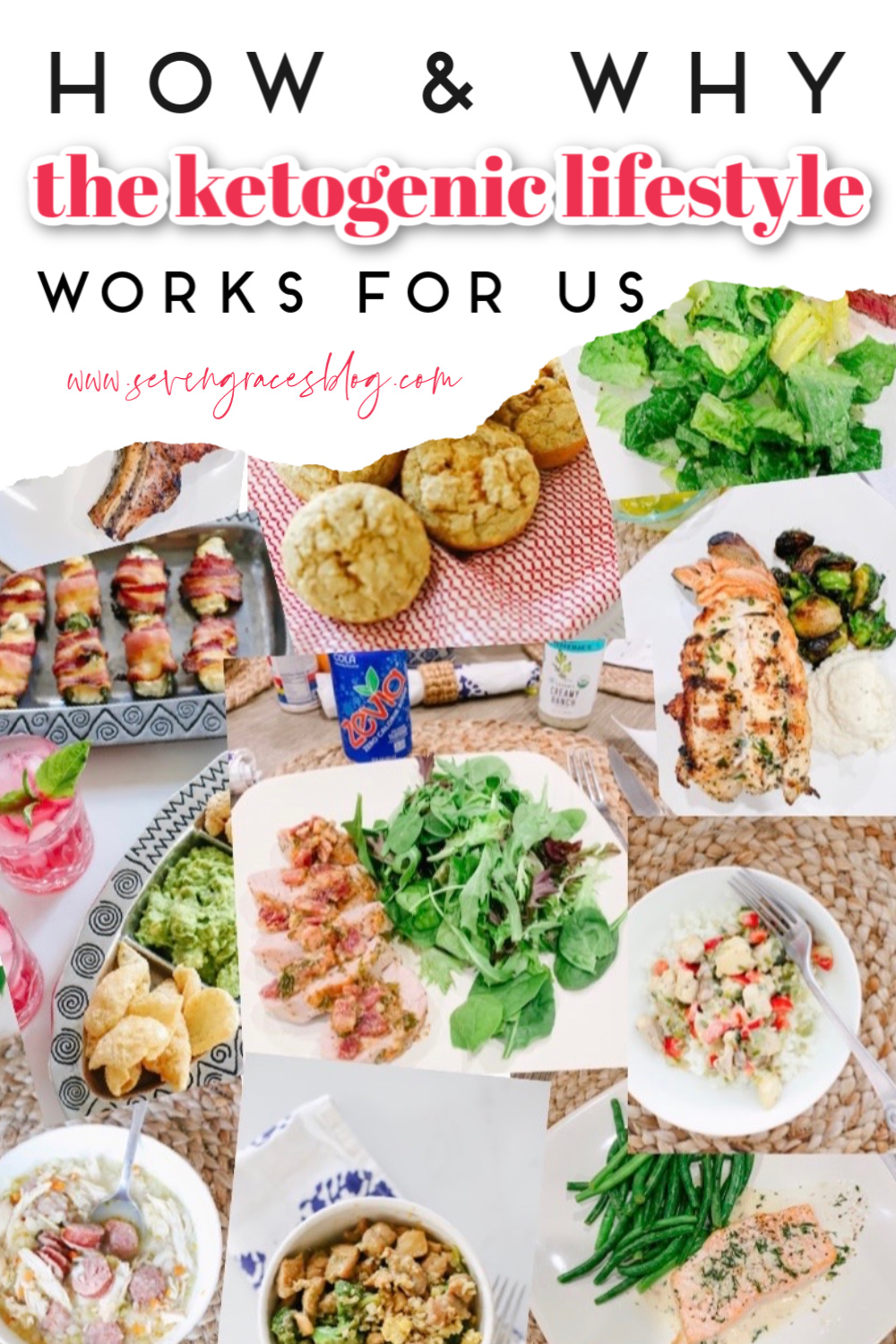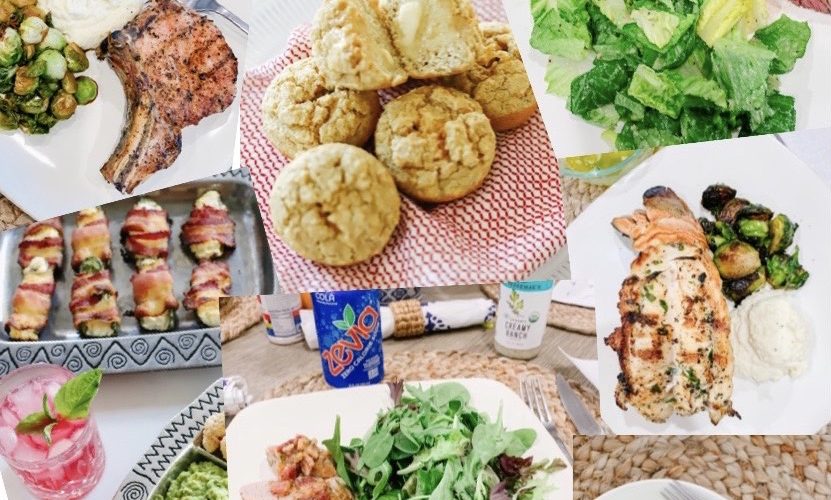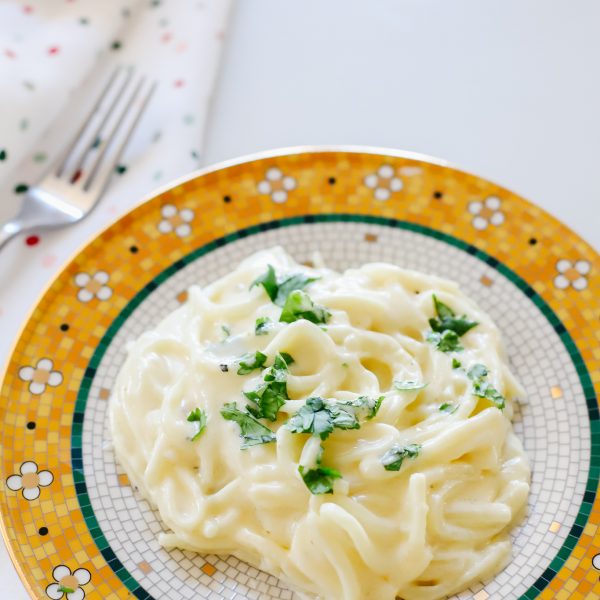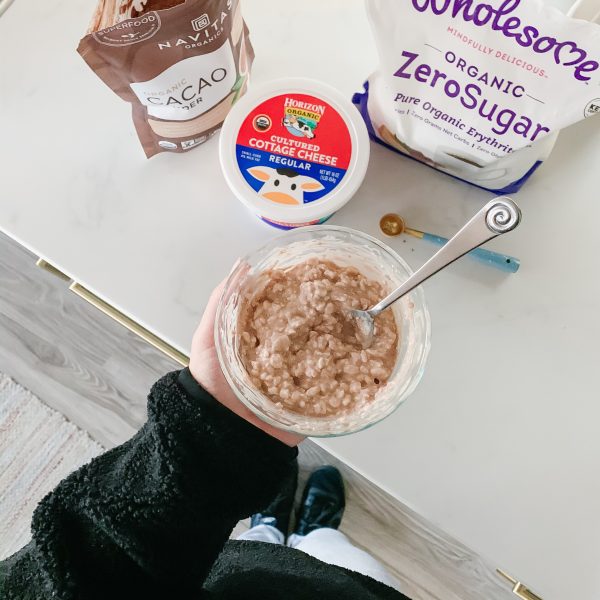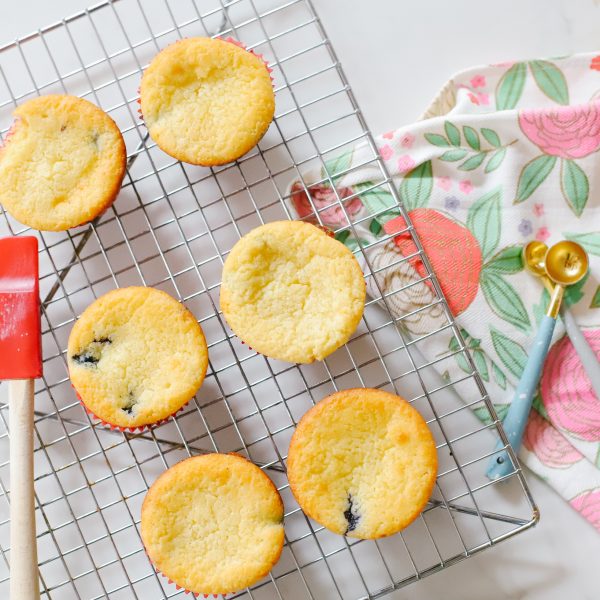
Okay, friends. The time has come. I’m about to spill the beans on how I became that girl obsessed with the Keto Lifestyle, and I have no shame. So let’s back track and fill you in on a little history in case you’re new around here, then I’ll walk you through why I did it, what it looks like, and why I’m not turning back.

SOME HISTORY
I’m a fresh 38 years of age. I’ve always been pretty active. I ran a marathon or two in my life, and I touted that the Paleo diet was the best thing ever for the longest time. However, all of that was after my diagnosis.
When I was 26, I was diagnosed with hypothryoidism, and I’ve been on medication for it ever since. My weight has fluctuated tremendously since that diagnosis, much like a yo-yo. When I had my kids, it especially went up, up, and up. I was miserable. I longed for energy and the love for life that I used to know.
I tried to eat as well as I could, but I love food. I’m a foodie, and as an introvert, food has always been a comfort.
THE BREAKTHROUGH
About two years ago, I had a mind shift. I was on the tail-end of battling some brutal postpartum depression, and I longed for a change for the better. I started caring about what I was putting in my house, what I was putting on my kids, and I wanted to rid my house of as many toxins as I could. That was phase 1.
Once I overhauled my house from as many chemicals as I could, I wanted to go a little further. What if I removed all the junk from my diet, too?! What a concept.
PHASE 2
A year and half into ditching the toxins from my surroundings, I knew something needed to change for me on the inside, too, but I still wasn’t quite sure how to do that.
I knew what I didn’t want to do: I didn’t want to count calories and I didn’t want to count macros. I can barely write things down in my planner, so I knew tracking anything was a no-go for me.
Michael, my husband, started the Keto diet in June of 2019, but I was completely skeptical. I said, “I’ll support you, but instead of trying that, I’m going to focus on workouts instead.” I needed to find my own way. I missed working out, so I found a gym and loved it so much. I was working out 4 times a week, lifting weights, and gaining muscle that I had lost over the years. But still, nothing was changing. I was still uncomfortable in my clothes and lacked some serious motivation in a lot of facets in life; I had become “stuck” in a rut. I did the gym thing for three solid months.
According to the scale, I had lost 4 lbs, give or take. I was eating the “Paleo” way and gaining muscle, but still, the results were minimal. I’m very much a progress-driven person, and I wasn’t seeing any progress. I had worked so hard, and honestly, I was so disheartened. But here’s the kicker: Nothing changes if nothing changes. I was still doing things the same old way I had done several times before, so of course I wasn’t seeing the results I wanted.
ALL IN FOR THE KETO LIFESTYLE
Meanwhile, Michael was all in with the Keto lifestyle. He had transformed right before my eyes, and the best part? He felt the best he’s ever felt. He used to take Claritin D every day, but he stopped that about a month into doing Keto.
During my whole workout stage, he had been sending me videos explaining the ketosis basics, giving me subtle hints that there’s really more to this than just some measly diet. I’m a science nerd, and it always fascinates me when research knocks your socks off. And little by little, my mind was blown.
I had always said I would never do this “Keto diet.” (Much like I said I would never use essential oils. Lol.) I thought it was horrible for you to eat fats all day. You guys. We’ve been duped! This whole time we’ve been brainwashed to think low-fat is good for us and carbs with sugars are good for us, when really, they’re the worst! It’s no wonder so many people live in pain and are sick all the time. It finally clicked for me after watching so many doctors talk about the ketosis lifestyle; that’s when I decided to try it. High fats, low-carb city, let’s go!
Michael had the answer I had been looking for; it just took me a little while to see. I was reading “Green Eggs and Ham” to Charlotte last night, and it totally reminded me of how I see this diet. You never know if you’ll like something until you try it.
What is the Ketogenic Diet?
I think the reason why so many people are anti-Keto is 1) they’re afraid to change and 2) they have done zero research. It’s a total mind shift in the way you see food. And believe me, I have heard that little line many times before, but it’s true!
Here’s a great scientific explanation from Dr. Eric Berg of what the Ketogenic diet is:
“A Ketogenic diet is simply a diet, which causes your body to run on what are called ketones instead of sugar from carbohydrates like pasta, grains or sugary foods. Ketones are a type of acid formed when your body begins burning stored or dietary fat for fuel instead of carbs. They’re actually a very efficient fuel for your body. The most abundant, and beneficial, ketone is called beta-hydroxybutyrate or BHB.
On a typical American diet, your body is constantly converting sugar from carbs into energy. However, when you change to a high-fat diet and limit your net carbs, your body starts producing ketones for energy. As a result, on a low carb diet, your body automatically begins burning fat.
In a Keto diet, the goal is to switch your body from burning sugar fuel to fat fuel.”
I highly, highly recommend reading Dr. Berg’s article, Healthy Keto Diet for Beginners. Not all Keto diets are create equally. We’ve loosely been following his advice and refer to his research often.
We also love to follow:
- Dr. Ken Berry on YouTube (Keto explanation & carnivore diet)
- Thomas DeLauer (more fitness-based)
- Jeff Cavaliere Athlean-X (this is a Michael recommendation)
Another great source we loved:
- The Magic Pill on Netflix
What do you eat on the Keto diet?
One of the most frequently asked questions I get all the time is, “What can I eat?”
Everyone is different and has a different methodology on how to go about a Keto diet, but the first thing you should know is that we do not count calories. We know what we CAN eat, and let the pieces fall as they may. We also read every single label of anything we buy, ensuring the ingredients are wholesome and as minimally processed as possible.
Here are some guidelines of what you CAN eat to get your body into Ketosis:
DO NOT CONSUME ANY SUGAR OF ANY KIND OR ANYTHING THAT TURNS INTO SUGAR QUICKLY–NOT EVEN FRUITS!
- Organic, grass-fed unprocessed meats, pasture-raised eggs, and wild-caught fish (the fattier the meats & fish the better)
- Bacon (not turkey bacon)
- Beef or pork ribs
- Uncured Bratwurst or sausage
- Uncured hot dogs
- Chicken WITH skin and fat
- Duck or goose
- Eggs
- Pork chops
- Pork rinds
- Fatty fish and sea food
- Tuna fish
An important note is that the leaner the protein is, the more it will elevate your insulin thus preventing ketosis. This is why higher fat protein is encouraged.
- Organic vegetables when possible:
- alfalfa sprouts
- cauliflower*
- leeks
- snow peas
- artichokes
- celery
- lettuce
- spinach
- asparagus
- cilantro
- mushrooms
- squash
- bamboo shoots
- okra
- cucumbers
- onions
- kale*
- dill
- parsley
- Swiss chard
- bok choy*
- eggplant
- peas
- turnips*
- broccoli*
- peppers (all)
- garlic
- seaweed
- cabbage*
- ginger root
- olives
- escarole
- zucchini
- tomatoes
- avocado
- collard greens
- salsa (w/out sugar)
- pickles (w/out sugar)
- Brussels sprouts*
- sauerkraut
*If you bloat with these foods – avoid.
- Healthy fats:
- All nuts (esp. macadamia nuts), with exception to legumes (i.e cashews), the least expensive we’ve found is Bayside Candy – Sincerely Nuts
- Nut butters without sugar
- Avocado
- Coconut oil – very important
- Cream cheese and sour cream
- Aged, hard cheeses
- Cheddar
- Swiss
- Pepper jack
- Mozzarella
- Parmesan cheese
- Fish oil
- European cheese
- Flax seeds and flax oil
- Seeds
- Heavy whipping cream
- Mayonnaise
- Olives and olive oil
- Low carbs
- Limit your net carbs to keep your body in ketosis. Choose healthier types of carbs ideally suited to a ketogenic diet such as green and leafy vegetables. You will be able to consume a small amount of berries too.
Foods to avoid:
- grains
- rice
- pasta
- cereal
- sugar in any form!
- corn
- soy
- legumes
- all fruits (except blackberries and raspberries as they have a minimal effect on blood sugar)
- honey
- agave syrup
- rice syrup
- maple syrup
- tubers like potatoes and yams
- alcohol (you should really limit any alcohol consumption regardless of carbs because it is very taxing on the liver, which is what we’re trying to avoid)
-
- Other sugars to avoid:
- aspartame
- NutraSweet
- Equal
- sucralose
- saccharine
- maltitol
-
Here is a sample of what our meals look like throughout the week:
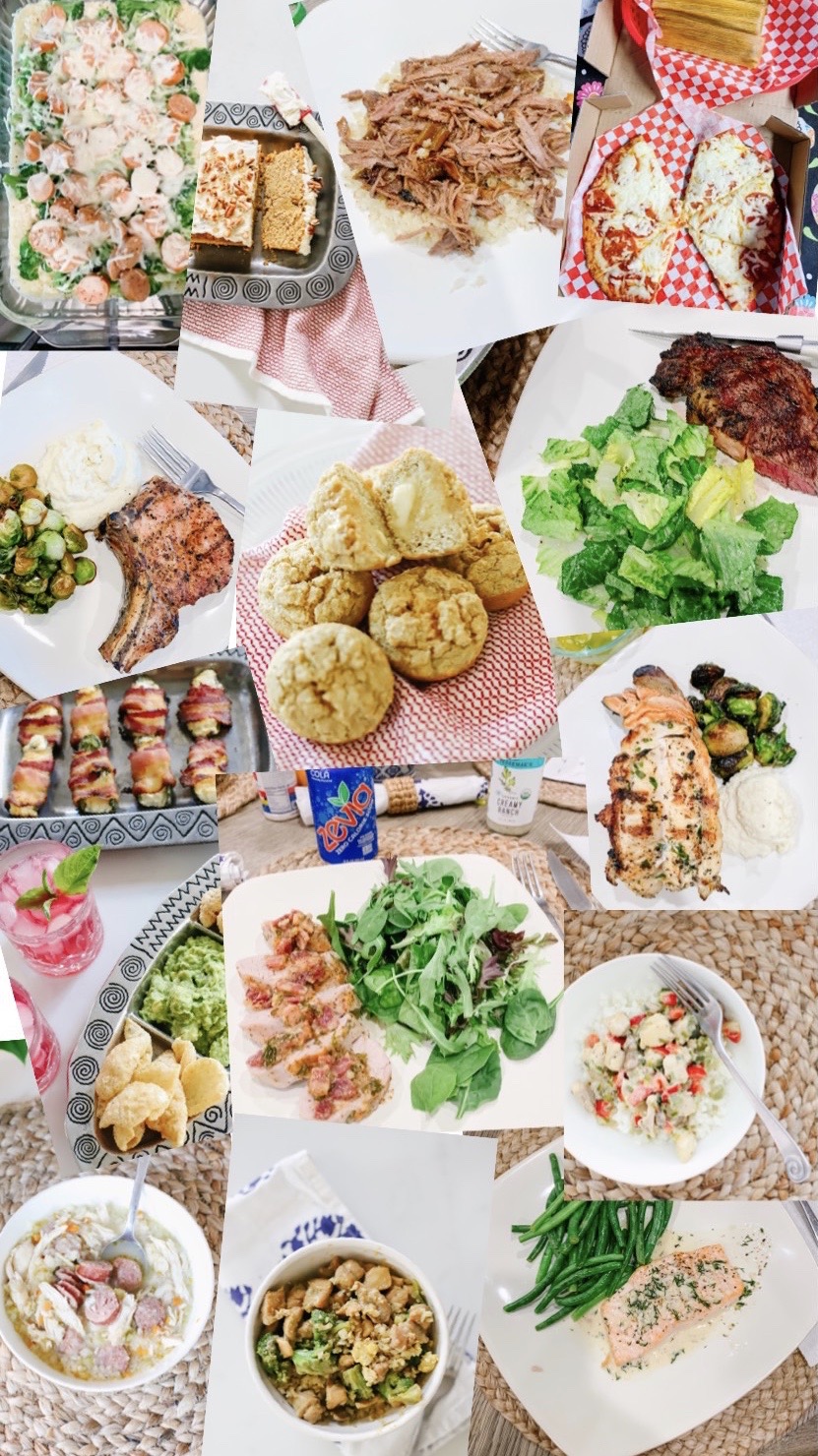
If you feel like you might miss your favorite high-carbohydrate foods, there are plenty of Ketogenic substitutes. One of the amazing things about the Keto diet is once you adapt to fat burning (full Ketosis), your hunger and cravings for carbs will really diminish, and you may not even miss your favorites. True story.
But as you can see, we aren’t deprived of anything. The pizza, pumpkin bread, and muffins you see are Keto versions of some of our favorite foods. Food subs are something you’ll become very familiar with once you’re in full swing of this Keto lifestyle.
We swap out sugar with erythritol and flour for almond or coconut flour. Finding substitutes for your favorite things that are not Keto friendly is totally possible and it’s been a lot of fun trying new recipes.
We eat a ton of cauliflower rice, leafy greens, and high fat meats. I cook with heavy whipping cream on occasion to make a savory meal, and I use coco aminos when I’m craving Chinese fried rice.
Here are some of my very favorite Keto friendly fridge & pantry staples:
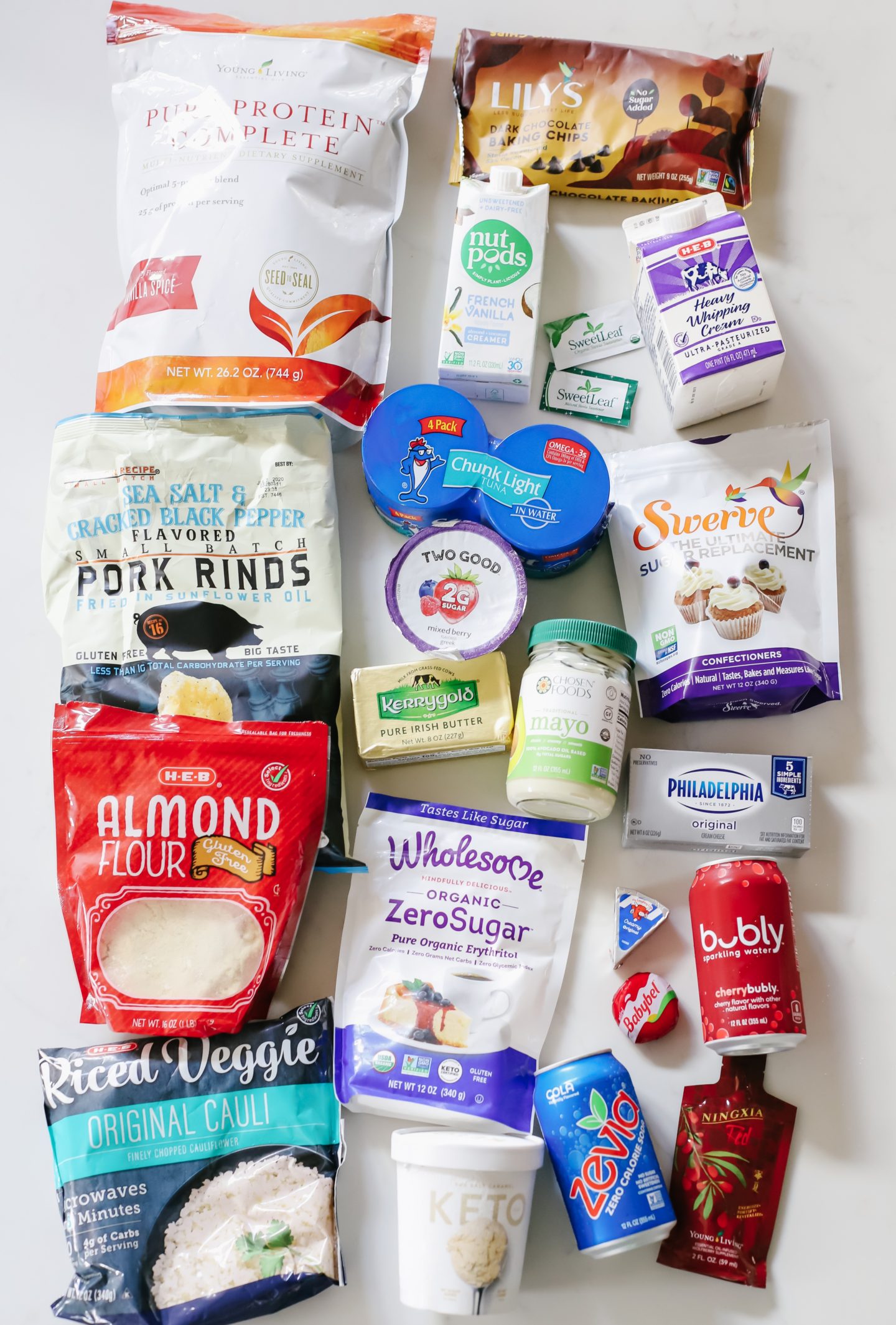
*Affiliate links used below:
- Young Living Pure Protein Complete Vanilla Spice (I use half a serving in my smoothies)
- Lily’s Dark Chocolate Baking Chips (zero sugar)
- French Vanilla Nut Pods (for my coffee)
- Sweet Leaf Stevia sweetener (for my coffee)
- Chunk Light Tuna — a super easy lunch
- Chosen Foods Mayo (zero sugar)
- Two Good yogurt (I love all the flavors)
- Kerrygold Pure Irish butter (I use this all the time)
- Heavy Whipping Cream
- Pork Rinds
- Cream Cheese
- Almond Flour
- Wholesome Organic Zero Sugar Erythritol
- Laughing Cow original
- Babybel cheese
- frozen riced cauliflower
- Keto Ice Cream
- Zevia Cola
- Bubly sparkling water
- Ningxia Red (for all the antioxidants)
Intermittent Fasting
Another thing I’ve done with this change of lifestyle is intermittent fasting. This is something that you might want to work your way up to as it does take some adjustments to your mindset and energy at first.
As a busy mom who works from home, I’ve never had a problem skipping breakfast. Give me coffee and I’m golden. I’m typically not a snacker either, so this wasn’t too far fetched for me. We eat dinner no later than 6 pm during the week, and I usually break my fast around 10 or 11 am the next day.
You can read more about Intermittent Fasting below as stated in Dr. Berg’s article, “Healthy Keto Diet for Beginners.”
“Intermittent fasting isn’t a diet; it’s a pattern of eating and not eating. It’s not about cutting calories; it’s about changing when you eat and when you don’t eat.”
Intermittent fasting triggers one of the most powerful hormones in your body. It’s called growth hormone (GH). GH has anti-aging properties and is the most powerful fat-burning hormone you have. As well, it protects your muscles and builds lean body mass.
There’s another substantial benefit from fasting: your insulin will be reduced.
Insulin is a hormone produced by the pancreas and is the body’s defense against glucose (sugar). When there is glucose in your bloodstream, your pancreas produces insulin to quickly remove the sugar and feed it to cells as well as store it as fat. This explains why you get a quick burst of energy after eating sugary treats. Of course, it lasts only for a second before insulin comes along to remove the sugar, leaving you with low blood sugar fatigue (otherwise known as a sugar crash).
Why should you care about your insulin levels? Because in the presence of insulin, you cannot lose weight; insulin prevents the burning of fat. In fact, insulin is so dominant it will actually block the beneficial growth hormone I mentioned.
What’s interesting about this is if you consumed 2000 calories in a given day but ate them spread out over six meals as compared to two meals, you would gain more weight because of this insulin factor.
Thus, intermittent fasting enables you to influence the action of insulin and growth hormone for your benefit.
How Intermittent Fasting Accelerates Fat Burning
Your body needs very little sugar to function. In fact, it requires just 1 teaspoon of sugar per day, which could easily be converted from the protein or fat you eat. You don’t need any dietary sugar. However, the average American consumes 31 teaspoons of sugar every single day—over 30 times the amount of sugar required by your body!
Sugar is highly toxic to the body. It causes damage to the nerves, affects vision, increases the risk of heart disease and stroke, and contributes to Alzheimer’s and other diseases.
When sugar is detected in your body, insulin will use it as the primary fuel source. Not because it is a high-quality fuel, but because it is so damaging your body tries to get rid of it as quickly as possible. People mistakenly take this body response to mean that sugar is the primary preferred fuel of the body. But as you can see, it’s not.
However, carbs aren’t the only thing that causes the body to produce insulin. Insulin production is triggered when you eat any type of food. As a result, every time you eat—even healthy snacks—insulin levels in your body spike and block fat burning. Bodies weren’t designed to eat and graze all day long. Which means snacking is a very bad habit!
A Healthy KetoTM diet combined with intermittent fasting maximizes fat burning by:
1. Greatly reducing the volume of carbohydrates (sugar), and thus insulin, in the body.
2. Providing a lengthy time period in which growth hormone can burn fat without interruption from insulin.
You may be thinking, how on earth do people stay with keto without feeling deprived, hungry, and cranky? The reason people – like you – can sustain this eating plan and easily stick to it is because cravings and hunger disappear, you’ll maintain stable energy levels, and feel more positive.
Supplements
We now are very in tune with our body and what it needs. I truly believe you’ll get to that point, too! We know we’re not going to get all the nutrients we need in our diet (I know no one who does), so we take plant-based, essential oil infused supplements. I’ll go into depth in another blog post about what I take and why on a different day. Just know that supplements have been crucial for me (and Michael as well) in this Keto lifestyle journey.
We take supplements to enough of our vitamin D, C, B, enzymes, electrolytes, greens, gut health, immunity, and collagen.
How Far We’ve Come & Where We’re Going

When I started this lifestyle change, I had no intention of doing this to “lose weight.” There are a bazillion “lose weight fast” fads and programs, and I have zero interest in those. I wanted to do this to get healthy. I wanted to see how healthy I could make my body, mind, and soul. This goes much further than a diet.
I get plenty of rest, drink tons of water, fill my home and help our bodies with Young Living essential oils aroma therapy, use non-toxic, plant-based cleaning supplies, take plenty of supplements, pray a ton, work on personal development daily, and most importantly fuel my body with the right foods it needs and wants. For me, that looks like the Keto diet.
As a result, my body has shed 15 pounds in a little less than two months. I didn’t even know I had that much to lose nor did I think it was necessary! I’ve dropped two pant sizes, and I have more energy and confidence than ever before. I don’t know about you, but when you feel your best after making such drastic changes, it’s really hard to go back to your old ways.
I saw someone on social media the other day talk about how the Keto diet wasn’t sustainable. To that, I say that’s nonsense. Eating healthy is completely sustainable. The evidence is there. Do your research.
Even though it’s frowned upon, we do have one “cheat day” a week where we indulge in the old favorites or have a drink, but once it’s over, it’s right back to our Keto ways. I feel that since we have a cheat day, it definitely makes this lifestyle sustainable, because even with a cheat day, we’re still seeing amazing results. There’s no turning back.
If you’re wanting a change, a real change, start small. Take daily steps to do better. If you want to try this Keto Lifestyle, I highly encourage you to get your spouse on board because it makes life so much easier.
Good luck, friend! I’m rooting for you!
